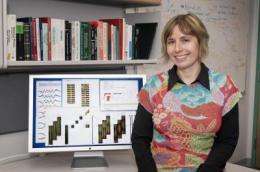Scientists use math modeling to predict unknown biological mechanism of regulation

A team of scientists, led by a biomedical engineer at The University of Texas at Austin, have demonstrated - for the first time - that mathematical models created from data obtained by DNA microarrays, can be used to correctly predict previously unknown cellular mechanisms. This brings biologists a step closer to one day being able to understand and control the inner workings of the cell as readily as NASA engineers plot the trajectories of spacecraft today.
"Thanks to the Human Genome Project, biology and medicine today may be at a point similar to where physics was after the advent of the telescope," said Orly Alter, assistant professor of biomedical engineering at the university. "The rapidly growing number of large-scale DNA microarray data sets hold the key to the discovery of cellular mechanisms, just as the astronomical tables compiled by Galileo and Tycho after the invention of the telescope enabled accurate predictions of planetary motions and, later, the discovery of universal gravitation. And just as Kepler and Newton made these predictions and discoveries by using mathematical frameworks to describe trends in astronomical data, so future discovery and control in biology and medicine will come from the mathematical modeling of large-scale molecular biological data."
In a 2004 paper published in the Proceedings of the National Academy of Sciences in collaboration with the late professor Gene H. Golub of Stanford University, Alter, who holds a Ph.D. in applied physics, used mathematical techniques inspired by those used in quantum mechanics to predict a previously unknown mechanism of regulation that correlates the beginning of DNA replication with RNA transcription, the process by which the information in DNA is transferred to RNA. This is the first mechanism to be predicted from mathematical modeling of microarray data.
For the past four years, Alter and her students worked with John F. X. Diffley, deputy director of the London Research Institute of Cancer Research UK, and members of his Chromosome Replication Lab, on experiments that were designed to test this prediction. The results, published online in the journal Nature Molecular Systems Biology on October 13, 2009, verify the computationally predicted mechanism.
A DNA microarray is a glass slide that holds an array of thousands of specific DNA sequences acting as probes for different genes, making it possible to record the activity of thousands of genes at once. Making sense of the massive amount of data DNA microarrays generate is a major challenge. In her Genomic Signal Processing Lab, Alter creates mathematical models by arranging the data in multi-dimensional tables known as tensors. She then develops algorithms to uncover patterns in these data structures, and is able to relate these patterns to mechanisms that govern the activity of DNA and RNA in the cell.
Source: University of Texas at Austin (news : web)
















